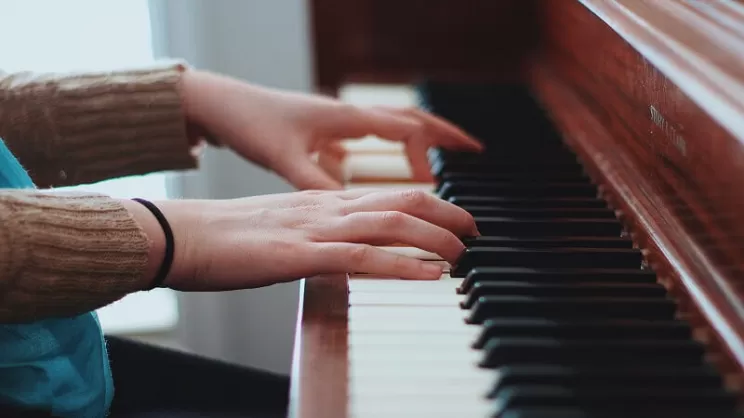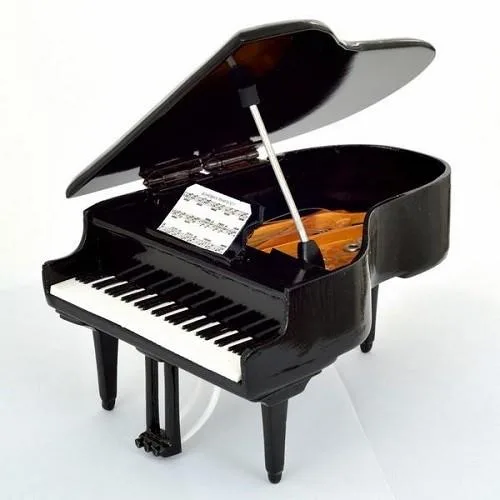What is a pianoforte and why is it such a beloved instrument? If you’ve ever been to a concert or listened to classical music, chances are you’ve heard the enchanting sound of a pianoforte. But what exactly makes this instrument stand out from other keyboard instruments? Well, I’m here to share all the fascinating details about this beautiful and versatile instrument.
In this article, we’ll explore the history and evolution of the pianoforte, how it works, and its unique features that make it an essential part of any musician’s repertoire. Whether you’re interested in learning how to play or simply curious about this iconic instrument, keep reading as we dive into everything you need to know about the pianoforte. So let’s get started!
So, what is a pianoforte?
A pianoforte, commonly known as a piano, is a musical instrument that produces sound by striking strings with hammers when keys are pressed. It was invented in Italy around the early 1700s and quickly gained popularity due to its versatility and ability to produce both soft and loud sounds.
The name “pianoforte” comes from the Italian words for “soft” (piano) and “loud” (forte), which refers to the instrument’s ability to play at different volumes depending on how hard the keys are pressed. This was a major innovation at the time, as previous keyboard instruments could only produce one volume level.
Pianos come in various sizes, from small upright ones to grand concert pianos. They also have different numbers of keys, with most modern pianos having 88 keys. Each key corresponds to a specific note on the musical scale.
Playing the piano requires skillful coordination between hands and fingers while reading sheet music or improvising melodies. It is considered one of the most versatile instruments because it can be used in various genres of music such as classical, jazz, pop, and more.
In addition to its beautiful sound and wide range of capabilities, pianos also serve as elegant pieces of furniture in homes or performance venues. Many famous composers throughout history have composed masterpieces specifically for this instrument.
Overall, whether you’re an aspiring musician or simply appreciate beautiful music, learning about pianofortes adds depth and appreciation for this timeless instrument.
Understanding the History of the Pianoforte
Let’s journey back in time, to the year 1700 when a man named Bartolomeo Cristofori of Italy brought an instrument into existence that would change the course of music forever. A new breed of keyboard instrument was born and it rang out with beautiful melodies across rooms, halls, and eventually entire theatres. This magical creation became known as the pianoforte, also referred to simply as “piano”. Now imagine sitting at this magnificent contraption, your fingers lightly touching its keys. Suddenly you’re not just playing notes – you’re telling a story through sound.
What sets the pianoforte apart from its predecessors? It lies in two significant words: soft (piano) and loud (forte). Before Cristofori’s invention, keyboard instruments like the harpsichord could only produce one volume level regardless of how hard or softly you struck its keys. But Mr.Cristofori had an innovative thought: what if he could design an instrument that allowed musicians to vary their expression by controlling volume?
- The Hammer Mechanism:
He achieved this by developing a unique hammer mechanism where each key struck a string allowing individual control over each note’s intensity.
- The Escapement:
Additionally, his clever ‘escapement’ design permitted hammers to fall back after striking instead of lingering on strings; thus giving birth to clear & crisp sounds without any blur.
The birth of pianoforte marked a monumental milestone in history! Imagine being there during those first performances – feeling every nuance with performers having newfound expressive power right at their fingertips! Truly transformative!
Exploring The Design and Components of a Pianoforte
Have you ever wondered what’s inside that beautiful, intricate instrument called a pianoforte? The name ‘pianoforte’ itself is quite enchanting. It originates from Italy and means “soft loud”, which aptly describes the unique ability of this instrument to create both gentle melodies and strong, impactful chords. A pianoforte’s design is based on a harmonious marriage between aesthetics and acoustics.
Underneath its elegant exterior, the pianofortes contain various components working together in concert. The heart of this charming instrument lies in its strings. Made of steel, these strings vibrate when struck by hammers – yes you heard it right- tiny felt-covered hammers! These are controlled by keys on the keyboard. But don’t be fooled; even though they’re small, their impact resonates throughout the entire instrument to create music that can stir your soul.
The belly bridge carries vibrations from the strings into another crucial component: the soundboard. This disk shaped wooden piece amplifies sounds so we can hear them clearly across large spaces like a grand concert hall or even just our living room.
The key components include:
- The frame: Crafted often from cast iron for strength and stability.
- Strings: Usually 230 precisely tuned ones producing individual notes when played.
- Damper Pedal: Controls whether notes ring out or stop abruptly according to player preference.
With every press of a key or pedal shift, numerous elements unite in perfect harmony within this magnificent creation known as the Pianoforte – an orchestration under fingertips.
Read also: used yamaha piano prices

Distinguishing Features Between a Pianoforte and Other Keyboard Instruments
In the vast orchestra of musical instruments, each has its own uniquely beautiful voice. But within families of similar instruments like keyboards, it might be challenging to discern their individual characteristics. One such keyboard instrument that stands out is the pianoforte, more commonly known today as just a piano. What sets the pianoforte apart from others in its familial cluster? It’s all about how it speaks its melodic language!
Pianofortes have a complex yet captivating mechanism at work inside them. When you press a key on this instrument, you’re doing much more than simply playing a note – you’re setting off an intricate ballet of hammers and strings! Unlike other keyboard counterparts where sound is created by plucking or blowing air through pipes (like in harpsichords or pipe organs), pianofortes generate music via hammers striking steel wires under tension producing those rich tones we’ve come to adore.
Yet another distinguishing feature between a pianoforte and other keyboard instruments lies in the control over volume and expressiveness it offers – hence ‘piano’ for soft and ‘forte’ for loud. This capability allows musicians to elicit profound emotion from listeners, drawing them into the narrative woven by notes drifting through time and space.
- The harpsichord, another historic member of the keyboard family cannot adjust volume based on touch – every note rings out with uniform intensity.
- An organ’s sole way to manipulate volume is not by keystroke force but rather using stops or foot pedals.
- A modern-day digital synthesizer, while capable of mimicking many different sounds including that of a piano, lacks that tactile feedback connection between fingers and keys which contributes significantly to dynamics.
Through these unique features – hammer-and-string operation and expressive control, the pianoforte truly distinguishes itself within the keyboard instrument family.
The Role of the Pianoforte in Classical Music
The pianoforte, also commonly known as the piano, plays a truly pivotal role in the sphere of classical music. Imagine for a moment, if you will, a grand concert hall filled with enthusiastic music lovers – all drawn to the melodious notes emanating from this beautiful instrument. The pianist at center stage expertly navigates through an intricate labyrinth of keys, each stroke producing sounds that reverberate throughout every corner of the room. Such is the power and beauty held within those 88 keys – an entire orchestra condensed into one stunning piece of craftsmanship.
In essence, the pianoforte has helped shape classical music and continues to do so till today.
- The piano’s wide range allows composers to weave complex melodies that can stand alone or harmonize perfectly with other instruments.
- Its unique ability to alter dynamics (a.k.a., volume) simply by varying key pressure gives expression & depth unattainable by its predecessor- Clavichord.
- In essence, it adds textures & layers to compositions making them more emotionally resonant.
Masters like Mozart, Beethoven and Chopin have used this instrument not just as a tool but rather as their canvas on which they painted some of their most profound masterpieces. When we listen closely enough – we can hear echoes from centuries past illuminating our present through timeless pieces played on this remarkable instrument.
You may also like: p515 yamaha piano price
Learning to Play: Basic Techniques for Playing the Pianoforte
Delving into the world of pianoforte, or simply piano as we commonly know it, is akin to embarking on a thrilling journey filled with melody and harmony. This magnificent instrument brings tones to life, stirring emotions and opening doors to countless musical possibilities. The first step in this journey involves getting acquainted with basic techniques for playing the piano, which lay down a solid foundation for your musical growth.
The initial phase starts by familiarizing yourself with the keyboard layout – 88 keys made up of white notes (representing natural tones) and black notes (indicating sharp or flat tones). Learning how to properly position your hands is crucial; imagine holding an apple under each hand while typing away at the keys. This relaxed, arch-like form reduces strain and promotes fluid movement across different octaves on the keyboard.
Then comes mastering basic note reading skills where identifying notes on staff lines becomes second nature. You’ll also need to learn rhythmic values—whole, half, quarter notes—and their corresponding rests.
- Scales: Practicing scales daily aids in developing dexterity and aids understanding of key signatures.
- Chords: Chords are essentially groupings of harmonized notes played simultaneously. They add richness and depth to melodies.
- Finger Strength Exercises: These exercises improve agility, speed, control over dynamics (loudness/softness), enabling more expressive playing.
In conclusion,
As you embark on this beautiful voyage towards becoming proficient at playing the piano remember that consistency coupled with patience will yield results over time. Don’t rush through learning; instead savor every note produced by your fingertips dancing upon those ivory keys! Just like any skill worth acquiring, achieving mastery takes time but there’s no greater joy than seeing your hard work bear fruit as you create music that can stir souls.
Conclusion: The Everlasting Impact and Importance of the Pianoforte
The pianoforte, more commonly known as the piano, is a crowning jewel amongst musical instruments. Its impact and importance in both music history and modern culture are truly remarkable. This elegant instrument has a wide range of tones, from soft whispers to powerful roars, which allows musicians to express an endless spectrum of emotions. The piano’s versatility makes it equally at home in classical concertos, sultry jazz bars or pop concerts.
Why is the pianoforte so significant?
- Cultural Influence: From Mozart’s sonatas to Beethoven’s symphonies, from Gershwin’s Rhapsodies to Elton John’s ballads – many timeless masterpieces were born on the keys of this grand instrument. It has shaped cultures and societies across centuries.
- Versatility: Few other instruments can match the depth and breadth of sounds that a piano can produce. Whether you want poignant melodies or uplifting tunes, all are within reach under adept fingers.
- Innovation: The impressive evolution of pianos over time – from early harpsichords to today’s digital keyboards – signifies its perennial relevance in our ever-changing world.
In conclusion, whether through its cultural influence, versatility or innovation potential – the everlasting impact and importance of the pianoforte cannot be understated. It continues to serve as an irreplaceable cornerstone for music creators worldwide – continually inspiring creativity while echoing memorable stories through its resonant strings.

